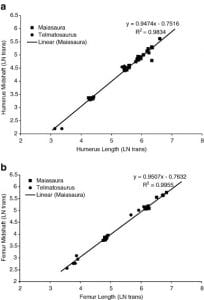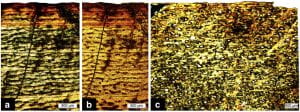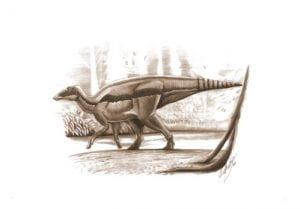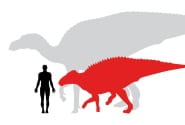| In 1899 Franz Nopcsa discovered Telmatosaurus transsylvanicus in the Haţeg region. He named it first as the genus Limnosaurus, but replaced the name with Telmatosaurus in 1903, when he discovered Limnosaurus had already been used for another genus. It measured around 4 m long and is a basal hadrosaur. When compared with the mean body length of other hadrosaurs (7-10 m) Telmatosaurus is about half the length and one-eighth the body mass.
By comparing humeral and femoral robustness (mid shaft circumferences plotted against length) of Telmatosaurus with Maiasauria, which has one of the best ontogenetic series among hadrosaurs, the smallest examples of Telmatosaurus are smaller than nestling Maiasauria and Telmatosaurus are slightly more robust than Maiasauria of a similar size. The latter are thought of as sub-adult, indicating that Telmatosaurus were downsized relative to the ontogenetic trend of Maiasauria (Figure 1).
|
 Figure 1: Heterochrony in the ornithopod Telmatosaurus, in comparison to its close relative Maiasaura from North America. Measurements of element length and midshaft diameter for humeri (a) and femora (b), showing that Telmatosaurus specimens plot in the lower part of the size range, but closely follow the growth trajectory (equations of the lines, and correlation coefficients at p < 0.001, are given) of the undwarfed relative Maiasaura. All measurements are natural logarithm-transformed (LN trans).
Figure 1: Heterochrony in the ornithopod Telmatosaurus, in comparison to its close relative Maiasaura from North America. Measurements of element length and midshaft diameter for humeri (a) and femora (b), showing that Telmatosaurus specimens plot in the lower part of the size range, but closely follow the growth trajectory (equations of the lines, and correlation coefficients at p < 0.001, are given) of the undwarfed relative Maiasaura. All measurements are natural logarithm-transformed (LN trans).
Juvenile characters of Telmatosaurus
Telmatosaurus is smaller than basal iguanodontians like Ouranosaurus and Iguanodon and retains features of the teeth of their juveniles (Weishampel et al, 1993). The maxillary teeth are narrow, diamond-shaped and equipped with a single centrally placed ridge, seen in juveniles of non-hadrosaurid iguanodontians, and like the maxillary teeth of derived hadrosaurids. The dentary teeth, however, are wider, asymmetrical and have several low ridges. These are also small, but seem to be intermediate between hadrosaurids and iguanodontians. They resemble the teeth of adult iguanodontians, so could be evidence of dwarfing through paedomorphosis.
 Figure 2: Histology of the long bones of the ornithopod Telmatosaurus transsylvanicus (a-c),(a-b) Overview of the bone histology of the femur of subadult specimen FGGUB R.1362 (femur length 25 cm). No secondary remodelling has altered the primary bone of the middle and outer cortex yet. Primary bone consists of fibrolamellar bone tissue with reticular organization of the primary osteons. Growth marks occurr regularly spaced throughout the cortex. (b) Same view in polarized light. (c) The femur of the oldest adult specimen MAFI Ob.3130 (estimate of femur length around 46 cm = max. size) reveals secondary remodelling of the primary bone up to the outer cortex. The bone surface is missing and thus no EFS was observed. Viewed in polarized light.
Figure 2: Histology of the long bones of the ornithopod Telmatosaurus transsylvanicus (a-c),(a-b) Overview of the bone histology of the femur of subadult specimen FGGUB R.1362 (femur length 25 cm). No secondary remodelling has altered the primary bone of the middle and outer cortex yet. Primary bone consists of fibrolamellar bone tissue with reticular organization of the primary osteons. Growth marks occurr regularly spaced throughout the cortex. (b) Same view in polarized light. (c) The femur of the oldest adult specimen MAFI Ob.3130 (estimate of femur length around 46 cm = max. size) reveals secondary remodelling of the primary bone up to the outer cortex. The bone surface is missing and thus no EFS was observed. Viewed in polarized light.
Bone histology of Telmatosaurus
The primary bone tissue of Telmatosaurus transsylvanicus consists of fibrolamellar bone with reticular primary osteon organization in hatchlings ad lamellar organization in sub-adults (Figure 2a-b) and adults (Figure 2c). As seen in Magyarosaurus, the fibrolamellar bone matrix of T. transsylvanicus has a strong lamellar component, suggesting that it too had a slower growth rate.
 Artwork: Telmatosaurus transsylvanicus
Artwork: Telmatosaurus transsylvanicus
Kindly provided by Mihai Dumbrava
Literature cited
- Benton, M.J., Csiki, Z., Grigorescu, D., Redelstorff, R., Sander, P.M., Stein, K., and Weishampel, D.B. 2010. Dinosaurs and the island rule: The dwarfed dinosaurs from Hațeg Island. Palaeogeography, Palaeoclimatology, Palaeoecology 293, 438-454. pdf.
- Weishampel, D.B., Norman, D.B., and Grigorescu, D. 1993. Telmatosaurus transsylvanicus from the Late Cretaceous of Romania: the most basal hadrosaurid dinosaur. Palaeontology 36, 361-385.
- Grigorescu, D. and Csiki, Z., 2006. Ontogenetic development of Telmatosaurus transsylvanicus (Ornitischia: Hadrosauria) from the Maastrichtian of the Haþeg Basin, Romania – evidence from the limb bones. Hantkeniana 5, 20-26.
- Horner, J.R., deRicqlès, A., and Padian, K. 2000. Long bone histology of the hadrosaurid dinosaur Maiasaura peeblesorum: growth dynamics and physiology based on an ontogenetic series of skeletal elements. Journal of Vertebrate Paleontology 20, 115-129.


